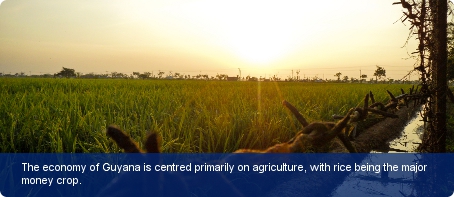Find a business in Guyana

The South American developing country of Guyana has hilly tropical forests, a narrow coastal belt, but natural resources of bauxite, diamonds, gold and manganese. Its simple economy is based around agriculture and mining. It has a GNI per capita of US$3,410 (2012), but has seen GDP growth of 4% per annum 2008-12. The main cash crops are sugar and rice, but drought and falling commodity prices have hampered growth since 1998.
Guyana’s agricultural sector is a vital contributor to the country’s economy and, together with forestry and fisheries, accounts for 17% of GDP (2010). Approximately 15% of the country’s population are employed in the sector (2010). The sugar and rice industries are at the forefront of agricultural production.
Over three-quarters of the country’s land mass is covered by forest (2005). The forestry industry is one of Guyana’s main sources of foreign currency income and the total export value of the sector was US$41.9 million in 2010 – a 7.9% increase on the previous year. Approximately half of the state owned forest areas were allocated for forestry production in 2009.
Guyana’s manufacturing industry contributes about 10% towards the country’s GDP and employs approximately 12% of the population (2010). Traditionally, the manufacturing sector has been dedicated to the processing of traditional agricultural products for local consumption. While these traditional manufacturing activities remain important, there is a growing interest in the country to expand value-added, export-oriented manufacturing industries.
Mining is an important part of Guyana’s economy, with the country being one of the world’s largest bauxite producers. The mining sector has contributed up to 10% of the country’s GDP in recent years. Among Guyana’s other mineral resources are gold, diamond, alumina and uranium.
As of 2010, although oil had been discovered, no indigenous sources of oil or gas had ever been exploited in Guyana. Coupled with absence of oil refinery facilities, the country must import all of its oil and gas requirements.
Major export destinations for Guyanese products include Canada, the United States, the United Kingdom, the Netherlands and Portugal. The value of Guyana’s exports was estimated to be about $652 million in 2009. Major imported commodities include petroleum, food and machinery. Guyana’s main import partners included the United States, Trinidad and Tobago, Finland, Cuba and China. Imports were valued at almost $1.1 billion in 2009. The economy’s heavy dependence on the export of six commodities – sugar, gold, bauxite, shrimp, timber and rice – which represent a significant proportion of the country’s GDP makes it highly susceptible to adverse weather conditions and fluctuations in commodity prices.
In 2001-02 the economy was producing moderate economic growth largely as a result of expansion in the agricultural and mining sectors, a more favourable climate for business initiatives and a more realistic exchange rate. In addition, the country had achieved fairly low inflation and still enjoyed the continued support of international organisations. The Inter-American Development Bank in March 2007 cancelled Guyana’s debt of $470 million with the Bank. But in November 2009, the Bank alongside the China Development Bank financed a $500 million hydro electricity project aimed at bringing down energy costs.
There are approximately 8,000 km of road throughout Guyana, of which only around 7% is paved. The majority of road infrastructure is located along the coastal belt. Air transport is central to the domestic economy as it provides a link between coastal areas and the densely forested hinterland.
Guyana is ranked 6th in the Latin America and Caribbean region for enforcing contracts and 8th for dealing with construction permits, according to the World Bank’s ‘Doing Business 2012’ study. These rankings measure the conduciveness of a regulatory regime in starting and operating a business.
The adult literacy rate in Guyana is 99% (2009) and virtually the entire population speaks English – the country’s official language.



